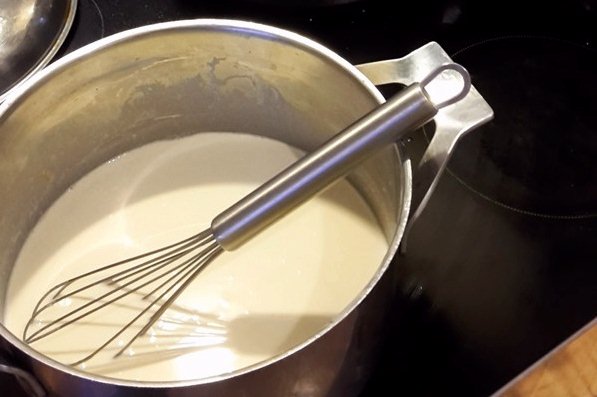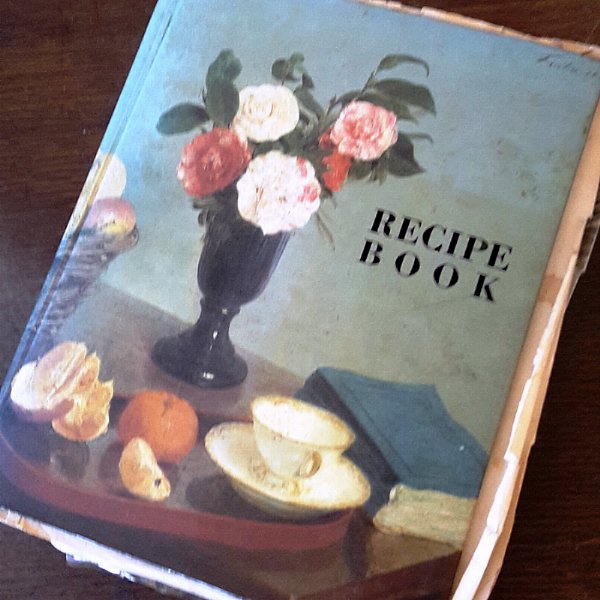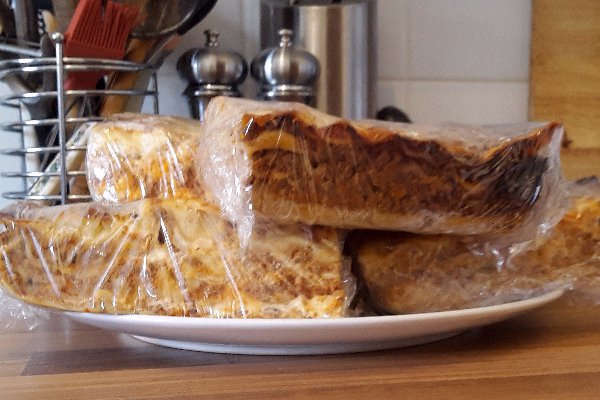A couple of weeks ago, I was brought up short by a moment of hubris.
What happened was this: A very dear friend, who has known me as well as my family since college and with whom I, in fact, used to live, came to stay the night. On her last visit we had sampled a local Vietnamese place so this time we’d be eating in. Thence came my moment of hubris. Secure in the knowledge that my culinary prowess would thrill her whatever I made, I asked “What would you like me to cook?”

Don’t Ask
Never do this. You’re hosting a dinner, not taking requests at the cocktail lounge out by the airport.
Don’t put people on the spot (unless they’re family, in which they’ll likely demand a given dish before you’ve even asked). Guests somehow never say “Oh I’m sure whatever you make will be divine!”, thus freeing you up to make the fiendishly impressive Middle Eastern feast you’d been planning. Instead, they will ask for precisely the dish you just cooked last week and can now barely bear the thought of. Or worse, they’ll say what my guest said: “Oooh! How about you make your lasagna?”
My lasagna? What could she be thinking? I don’t have a lasagna! I’ve never made a lasagna in my life. And that’s what brought me up short: I HAD NEVER MADE A LASAGNA IN MY LIFE.
Nope. Not once. I’ve raised and baked my own sourdough starters and breads, attempted homemade potato chips (don’t), make my own chicken stock, have become quite the dab hand at quick pickling, can whip up a meringue without batting an eye, can throw together the world’s sexiest crab linguine in a matter of moments, keep my own home za’atar blend going at all times, have run up more ragus and blown through more beschamels than I can count. But I’d never made a lasagna.
You may think this is no big deal. And I suppose it isn’t in the grand scheme of things. After all, I’m no more Italian than an Arbroath Smokie. But I am a self-avowed foodie. Never having made a lasagna felt like having missed an important rite of culinary passage. It’s one of those dishes you do. It’s like being an American and never having seen “It’s A Wonderful Life“.

The Origins of the Loomer Lasagna
So why hadn’t I ever made a lasagna, and why did my friend – who knows me very, very well – think I had?
The answer to the latter question provided the answer to the former. My friend and I had indeed dined on lasagna with my family on more than one occasion, but I was not the one who had cooked it. My friend was thinking of my mother’s lasagna. My mother’s lasagna was the stuff of dreams; a sumptuously meaty and creamy dish anyone would easily remember twenty years later.
“Now hang on, Patrick,” I hear you cry. “It’s well documented that your Mother was English to the core. She was no more Italian than an Eccles Cake. Nor was she a woman known for her enthusiasm for the kitchen. How on Earth could her lasagna be so legendary?”
It’s true that my mother was not fond of cooking as a rule. Working full time and then still getting dinner on the table for three picky children wore the shine off that penny for her. I have often described her as unenthusiastic about the kitchen but she had her ‘party pieces.’ She was famous for her marmalade and her fruitcake, both of which required a significant amount of kitchen time and effort. She was also famous infamous for her moonshine, (but that’s another story.) She also had a holy trinity of dishes that were guaranteed crowd pleasers, dishes we children requested in rotation at each important homecoming or momentous occasion, dishes to which we were unswervingly devoted through the years. They were:
- Chicken Othello (a chicken roasted in honey and butter, thus giving it a deliciously burnished skin and a breathtakingly impolitic moniker),
- Poor Man’s Stroganoff (wherein a beef stew is finished with sour cream and served over egg noodles and diners collapse in deliriums of delighted repletion) and
- her lasagna, which was quite simply the greatest, most unctuous pasta dish known to man.
The origins of the first two dishes were not known to us kids but we were well aware of the origin of the lasagna. Because the lasagna was not truly my mother’s lasagna, at all. In fact, we were there when my mother met the source of this amazing Italian masterpiece, just where you would expect to meet such a person: Nigeria.
We were living in Lagos, Nigeria in the mid-1970s, and such were the circumstances of the day, that the varying diplomatic officers and families of differing countries wound up as one large community. The children all went to the same International School and we all used the same Ikoyi Club pool. So it was through us kids that my mother was introduced to Mrs Pieroni, the lovely Italian lady who, in the culinary currency of the day, swapped recipes with my mother. I have memories of Mrs Pieroni’s lasagna recipe being THE recipe du jour; of suddenly every expat home serving Mrs Pieroni’s Lasagna at almost every occasion. I acknowledge that my memory may well be playing tricks here. After all, such was the torpid heat and humidity in Lagos that a hearty meal like lasagna would be exhausting to eat, let alone prepare. But regardless, such was the deliciousness of this dish that it instantly found a place in our hearts. We might be forgiven for starting to define periods of our lives as being BL (Before Lasagna) and OHA (Occasionally Happy After).
Why A Dish So Rarely Made?
Why “occasionally?” One of the reasons, I suspect, that we adored it so was because of my mother’s holy trinity of dishes, it was the one she made most rarely. It’s not difficult to see why. A true lasagna is a bit of a process.

There’s not one but two sauces to make – one of which must cook for at least a couple of hours- and then assemblage and baking. It’s most easily accomplished over two days, but even that was the kind of kitchen commitment that gave my mother pause. So, we would bide our time, wait for an especially good report card, or the return of a sibling from college or points west – moments of true import. Otherwise my mother would simply mutter about:
- being on a diet (Usually Dr Herman Tarnower’s Scarsdale Diet – “Look what happened to him!” we would cry)
- not having countless hours to spend stirring a pot,
- the weather being a tad too warm for such a dish
- your father’s spaghetti Bolognese be much lighter?
So, every lasagna dinner was hard won for us, and all the more delicious for it.
As the years went by and my mother began to fade, that lasagna faded away as well. At least until my sister – with two hungry sons of her own- took up the mantle. Why didn’t I? I’ve come to think it was a form of hubris also. I’d learned to make my mother’s other two great dishes, to make them my way, to adapt and “improve” them with more tony ingredients and extra processes (in both cases the addition of garlic and wine. My mother loathed garlic and I love wine).
But, I tell you, that lasagna was perfect; there was nothing about it for me to change; to make mine. And I was young and arrogant enough to feel a need to stamp my mark on whatever I cooked. I had, of course, tasted other lasagnas – from very pleasant homemade plates to those depressing “open lasagnas” of the 1990s that resembled rumpled bedding. None of them had quite measured up. None of them were THE lasagna. I like no ragu as much as my own except the ragu for my mother’s lasagna, but it never occurred to me to make a lasagna with my ragu, or to learn to make a spaghetti ragu from hers.
The Lasagna Calls
Then my mother was gone, and that amazing, delicious dish was somehow gone with her. In the ten years since my mother’s dish I think had the lasagna once or maybe twice at my sister’s house. My sister is an excellent cook and made the dish beautifully, exactly right, in fact. It tasted exactly how it did when my mother made it. But delicious as it was, it made me sad. It made me lonely for my mother. Well, lonelier; for so many years – and even now all too often – I was never not lonely for her. Eating her lasagna, especially with my family, was like my mother being drawn back to us, but trapped at a threshold and never quite reaching into the room. So in the last decade since my mother’s death, lasagna was a dish I’d avoid. Hers was too painful, and not hers wasn’t enough.
You may think that I took this all rather too much to heart – and perhaps I did. But grief encompasses much more of our lives and selves than we are ready for, and parts of us that heal quicker than others. Then there is the emotive nature of food. A beloved dish is nurturing beyond nutrition; it is an act of love, a memory of that love. These important, beloved dishes of our childhood become flashpoints for places in you that haven’t healed as quickly. My mother and I had a complicated relationship around food. She rarely saw my skinny self take a big helping, much less ask for seconds or squabble with my siblings for leftovers, so it brought her much joy when I did. A table laden with her lasagna was always just such a time. So while the dish itself made me happy; my greed for it made her very happy too. Memories of those moments can be warm, but they can also be so clear that they’re sharp as well.
That same greed that, thankfully, finally overcame my other feelings on the subject. Realizing that I had just never cooked a lasagna was a shock. Realizing why brought up a lot. But what it ultimately brought up was that I would either work through it and learn to make my mother’s lasagna, or never make or maybe even eat lasagna again. (Seriously, it is that good.) I can see myself eating other lasagnas as long as I can have the greatest one again.
Tackling the Loomer Lasagna
So, having made my Chicken Paprika as per my friend’s 2nd place request (and yes, I had just finished the leftovers of a previous batch two nights before) I got out my mother’s recipe book, and sought out the Holy Grail.

My first – somewhat shameful – discovery was that my mother was a more honest cook than I had given her credit for. So ineradicable was my mother’s loathing for the bulb that I had always assumed the lack of garlic in her lasagna (I’m telling you: it’s SO GOOD you don’t miss the garlic in a ragu!) was a stealthy omission on her part. But as i looked, I saw that there was no garlic listed in the ingredients. This was the very recipe typed out and given to her which she taped into her recipe book so this was not an ommission on her part.
My second discovery was that the recipe did call for white wine – which I had no memory of my mother ever using. I made it with the wine, and it tasted precisely as I’d remembered, so perhaps she had. At any rate, that was something of a beacon as I was planning on making this strictly by the book. No Patrick flourishes or switcheroos. Just respectful obedience. The second beacon came when I was frantically searching through my various casserole dishes and roasting trays, seemingly unable to find a lasagna-proportioned piece. And there is was. At the back of my cupboard was the now somewhat battered roasting tray I always saved for Thanksgiving. I had inherited it from my mother and it was the very same tray in which she had baked her lasagna.
I have to tell you that making the lasagna (making the two sauces, the cooling, the assembly, the chilling, the baking) was terribly lonely at times. I would be stirring the ragu and wondering why I was making this dish when there was no one I was making it for. Lasagna is a big dish – a feast, intended to feed many, to enhance a special occasion, a dish you make for someone. There’s something parental about it. Was I just making it to dispel a demon of sorts, to prove that I could? I was still alone. Other challenges presented themselves – the logistics of laying the lasagna sheets was one. I didn’t know how she did it. I had no memories of being with her when she worked on the dish – only when she served it. I might have been handed a couple of beacons, but I still felt like I was somehow flying blind.

But Oh. As I started to taste the ragu along the way, visceral taste memory came flooding back- and it felt surprisingly good. Then came the pride as I cut myself a portion after it had baked, seeing legit layers of pasta and sauce and pasta and sauce and cheese that held together and oozed just enough to entice. And then more memories as I sat myself down at the dining table and took that first bite. It’s hard to describe how much that moment meant to me, except to say that it felt and tasted good in every possible way. I was alone and then not at all. The lasagna was now mine too (because hell yeah will I be making this again) but still completely hers. I was still tasting her desperately missed love in every bite, but now I wasn’t too raw to savour it. I cried of course, but my tears weren’t bitter. I could feel her love for me and I could feel me growing up a bit again. It was, as they say, everything.
Later, as I wrapped portions in cling film for the freezer (delighting in the fact that the remainder of the lasagna was, unlike in my childhood, ALL MINE) – I suddenly thought of my mother’s friend Mrs Pieroni, whose lasagna this truly was. We had found that family again in Greece a couple of years after Nigeria, the way that those in Foreign Service often do, but had lost touch since then (at least to my knowledge). I wondered if this was Mrs Pieroni’s mother’s lasagna? And her mother’s before her? I wondered if Mrs Pieroni was still on this earth and cooking her lasagna, or if she is also gone. If that’s true, do her children now make it in honor of their mother as I will always now make it in honor and invocation of mine? Is it for them the talisman it has become for me? I believe so.

It was my mother’s birthday the other night. That morning I got one of the portions of lasagna out of the freezer to defrost for a solo dinner to celebrate her. As I slogged through what was rather a hard, sad day, it brought me such comfort to know that at least in some way, my mom would be waiting for me when I got home.
Here is the recipe for Mrs Pieroni’s (and my mother’s and my sister’s and now my) lasagna. I’ve made no alterations other than the grammatical. I haven’t added the instructions for pre-cooking the lasagna sheets since nowadays I’m guessing we all use the no-cook kind. Any way instructions are on the box if you don’t. With my shamefully scant knowledge of the regionalism of Italian cooking, I rather suspect that this recipe comes from the North. The lack of garlic, the richness of the dish (there is heavy cream in the beschamel and the ragu) are what make me suspect this. But who knows? My sister makes it without the heavy cream in the ragu, and it was delicious. I made it with, and it was delicious. Mrs Pieroni herself said it was optional. She also said that about the white wine. I’d venture to speculate that the one balances the other.
I made it with both, and I think the acidity from the wine cut the richness of the cream nicely.
You may want to wait until a colder season to try this, it has after all fabulous stick-to-your-ribsness. But I’d just wait until a slightly cooler day. Or just turn on a fan and dive right in.
MRS PIERONI’S LASAGNA
(serves 8, or me 6 times)
Make ragu (meat sauce) first.
What you need:
- 4 tablespoons butter
- 1 cup chopped onion
- 1/4 cup finely chopped carrots
- 1/2 cup finely chopped celery
- 2 tablespoons olive oil
- 1 kg ground beef
- 1/2 cup dry white wine (optional)
- 2 cups beef stock
- 10oz/ 300ml tomato paste
- 1 cup heavy/double cream (optional)
- 1/4 teaspoon (or a good grating of fresh) nutmeg
- salt and pepper
What you do: Melt the butter in a heavy skillet or frying pan then add the onions, carrot and celery. Cook for about 10 minutes over lowish heat, stirring frequently until they have softened. Transfer to a 4-quart saucepan. Heat the olive oil in the same skillet and brown the meat, stirring it constantly to break up any lumps. Add the wine and cook until there is almost no liquid. Pour the meat into the saucepan with the vegetables and add the tomato paste, the beef stock, and 2 cups of water. Simmer partially covered, stirring occasionally, for a couple of hours until the sauce has reduced and thickened. Add the heavy cream and the nutmeg for the final 10 minutes and season after tasting. Leave to cool.
Make the Besciamella (white sauce)
What you need:
- 6 tablespoons butter
- 6 tablespoons flour
- 2 cups milk
- 1 cup heavy/double cream
- 1/8 (or a good grating of fresh) nutmeg
- 1 teaspoon salt
What you do: In a large saucepan, melt the butter and stir in the flour. remove the pan from the heat and and pour in the milk and cream all at once, beating with a wire whisk until the flour is dissolved. Return the pan to high heat and cook, stirring constantly. When the sauce boils, reduce the heat and simmer, still stirring, for 2-3 minutes until it thickens into a smooth cream. Remove from the heat and season with nutmeg and salt. If you still have lumps, cool the cream and use a blender to make it smooth.
Assemble the lasagna
You will need:
- 500g no-cook dried lasagna sheets
- 2 cups grated cheese (if Parmesan not available use sharp cheddar or other-I used Grana Padano)
What you do: Butter a casserole dish and spread a layer of lasagna sheets over the bottom. Spread some meat sauce over the noodles and then a layer of besciamella, using a spoon to spread them evenly. Sprinkle with cheese. Repeat. Finish with a layer of lasagna, besciamella and grated cheese. At this point you can freeze it or keep it in the fridge for up to two days. Bake when needed in a medium hot oven for 20-40 (if chilled first) minutes, until the top is brown and bubbly.
